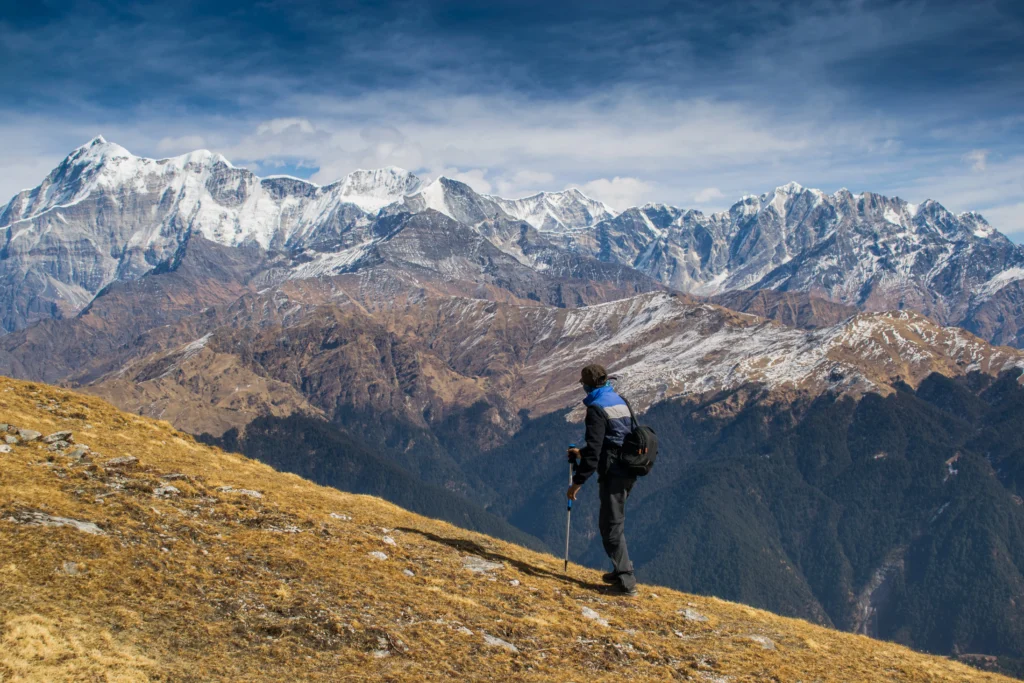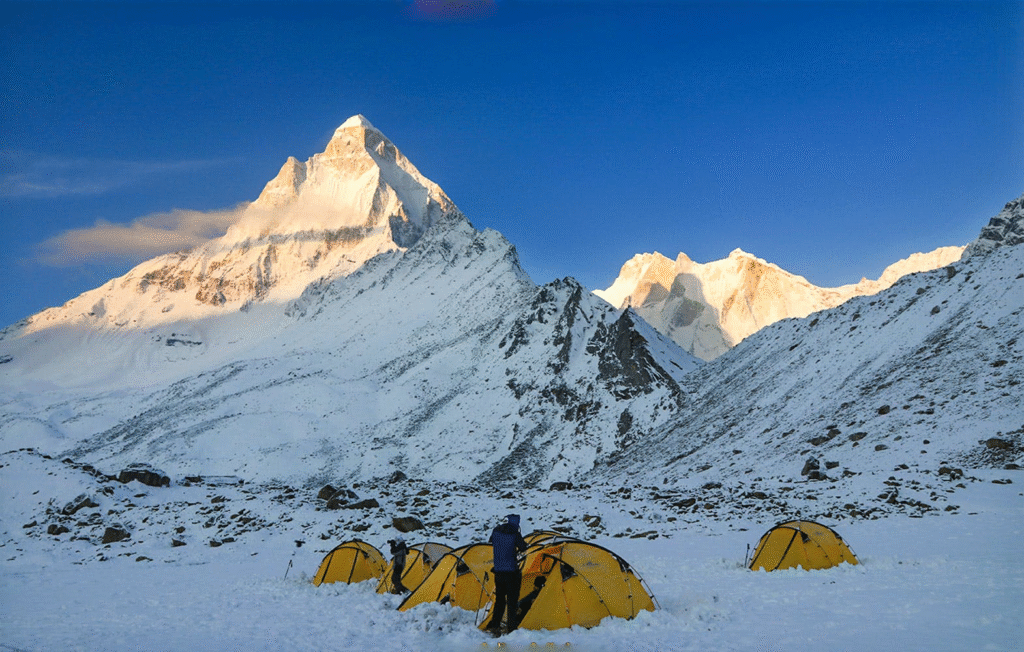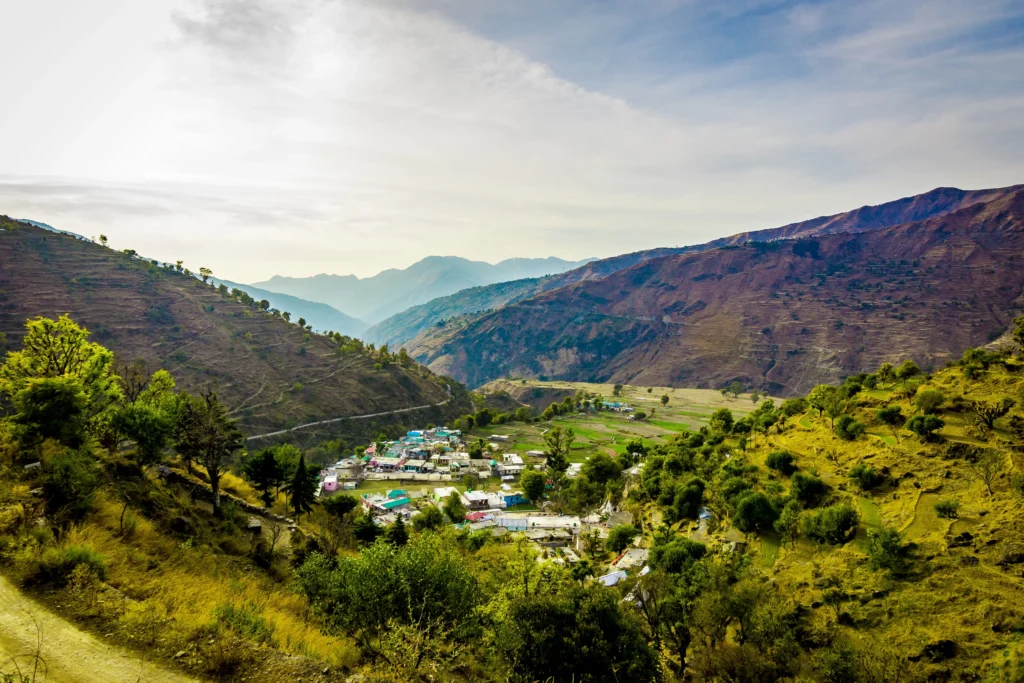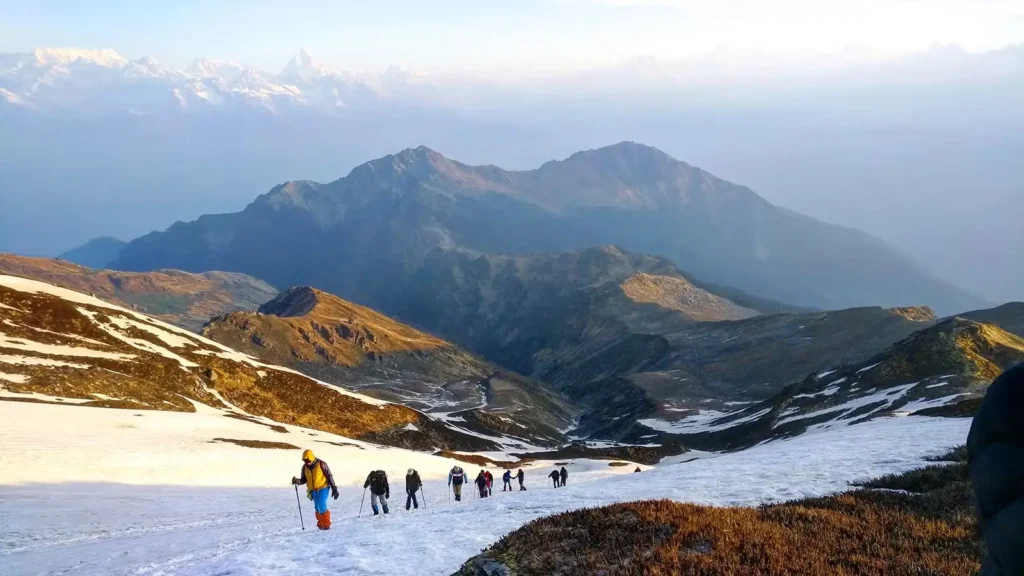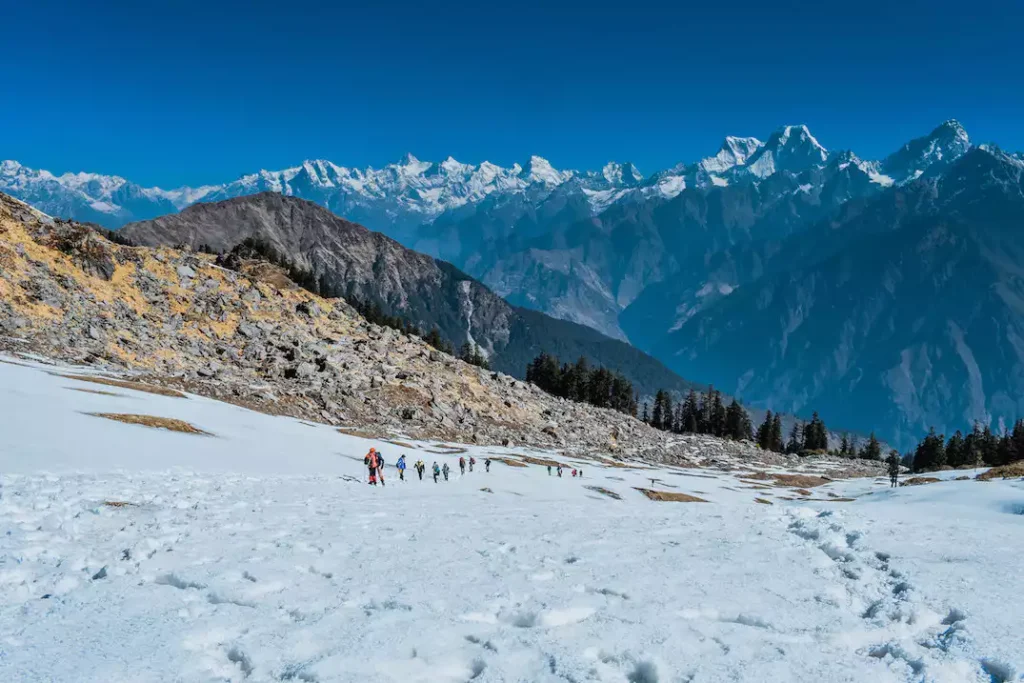
Some trails in the Himalayas are not just routes; they’re narratives — living stories scored into the terrain. One of such expedition is the Kuari Pass Trek. Dubbed the Lord Curzon Trail, it bears its exploration legacy and presents some of the loveliest views of that section of Garhwal Himalayas. Take your pick: standing on a high pass, with a 180-degree panorama of snowy behemoths such as Nanda Devi, Kamet and Dronagiri outstretched before you. This journey is a walk into history, thick forests and vast meadows – a true Himalayan classic.
The Kuari Pass trek is popular for a reason. It was discovered for the treks by Lord Curzon in 1905 and its beauty has attracted trekkers ever since. This trail provides the classic Himalayan experience: awesome, high mountains, fertile valleys, peaceful campsites and a great sense of being in nature. The strength of the Kuari Pass Trek lies in its accessibility, it’s open to all trekkers, but for experienced trekkers who are searching for challenge that is unforgettable, this journey will be deeply rewarding. This guide will help walk you through everything you need to get started on this amazing journey.
About the Kuari Pass Trek
Situated in the heart of Garhwal Himalayas, Kuari Pass Trek offers an elevtion up to 12,500 feet. The word Kuari translates to “doorway,” and it indeed feels like a doorway to an amphitheater of spectacular peaks. Its lore dates back to the period of British colonial rule, this was the route taken by Lord Curzon, who was then the Viceroy of India, and ensured its place in trekking legend.
The journey starts from the vicinity of Joshimath, a centre for culture and pilgrimage. As you climb, you get further from civilization and closer to unspoiled nature. The path passes through some ancient villages, here you can observe and experience the hard settled life of Bhotiya community members. This combination of stunning landscapes and cultural immersion means the Kuari Pass Trek is wholesome; appealing to both the adventure-seeking spirit and cultural soul.
Why should you go for Kuari Pass Trek?
In an area teeming with trekking choices, the Kuari Pass Trek is one of those treks for which you do not need too much time or experience yet it remains impressive because of what it offers.
There are the views, first and foremost. Few treks provide as panoramic and spectacular a view of India’s highest, most revered peaks. To behold the country’s second-highest mountain, Nanda Devi, glowing at sunrise is a moment that sticks with you.
Also, the trail is beginner friendly. It does include some tough climbs but the fairly gradual ascent and moderate schedule make it possible for practically anyone that is reasonably fit. No matter if you are trekking at high-altitudes for the first time.
And, perhaps best of all, the landscape’s sheer variety. You will hike through thick oak and rhododendron forests, along lush green meadows (bugyals) and snowy trails in winter. The ever-changing landscape means no two days on the trail are the same.
Kuari Pass Trek Highlights
This hike is filled with unforgettable memories and breathtaking moments.
Himalayan Views for Days: The big draw is the panoramic view from the pass. You have a front-row seat to an impressive string of peaks, from Nanda Devi and Dronagiri in the south-east, through Kamet and Chaukhamba to Hathi Ghoda Palki (HGPK) and Neelkanth in the west.
Mesmerizing Forests: Route passes from some of the best forest of Himalayas. Plunge under a high canopy of historic oak and deodar, as well as rhododendron trees that drape the slopes a frothy riot of pink and red blooms in spring.
Breathtaking Bugyals: You pass through picturesque high altitude meadows, or “bugyals” such as Gorson Bugyal. The wide, rolling pastures provide a perfect antidote to the rocky slopes and thick forest.
Camping under starlit skies: Nights spent at campsites like Tali and Khullara are beautiful. Options From city lights there are dementia-inducing amounts of stars in the sky that give a sense of tranquility and awe.
Itinerary for Kuari Pass Trek Day 1: Drive from Haridwar to Joshimath (275 km) = 10-11 hours Reach Haridwar early and board an SUV with fellow trekkers.

Attention to timing is key in our 6 day itinerary for proper acclimatization and enjoyment.
Day 1: Drive from Dehradun to Joshimath (1,875 m / 6,150 ft)
The journey in between is a long one and you are sure to attracted with the spectacle if not of Dehradun itself then it starts as we pick you up there for a beautiful drive to Joshimath. This 9-10hr trip, in itself is an experience as it passes through the Panch Prayags: Devprayag, Rudraprayag, Karnaprayag, Nandprayag & Vishnuprayag. You’ll ride alongside the fierce Alaknanda River, as the landscape changes from foothills to towering mountains. We will check into a guesthouse in Joshimath, a hubbub of a town that is often the starting point for treks and pilgrimages.
Day 2: Joshimath – Dhak – Gulling Top (2,900 m / 9,515 ft) At a distance of four hours Beautiful wildflowers: You need at least three days to reach the Valley of Flowers and come back to Joshimath.
After breakfast, we drive a little bit to Dhak village and starting point of our trek. The path starts with a gradual climb and passes by picturesque villages and terraced fields. As you stop to greet villagers along the way, you’ll get a fantastic sense of local living. We will have a climb of around 5 -6 hours over 5km which gets us to our first camp at Gulling Top. This pretty little meadow set amid forest provides first really nice views of Dronagiri. We’ll spend the night here, taking in peace of the mountains.
Day 3: Gulling Top to Tali Forest Camp (3,310 m / 10,860 ft)
Today the walk is an easy one and not very long (something like 4 km in total, which can be arranged for walking in around 4 or 5 hours). The trail leads us further into a virgin forest of oak, rhododendron and walnut trees. The path is hilly and even, making the move interesting. As you gain altitude, the views begin to spread out, showing off additional peaks in the area. We will arrive at the Tali Forest Camp- with a frozen lake (during winters) and thick alpine meadows. Spend the night with a hot dinner and peaceful forest surrounding you.
Day 4: Tali Forest Camp – Kuari Pass – Khullara (3,810 m / 12,500 ft)
It is the most anticipated day on Kuari Pass Trek. We get up early to trek for the pass. The path emerges from the woods into an open meadow known as Khullara, which marks the start of Kuari Pass trek. The home stretch is a tough with an insanely rewarding ascent. When you get to the top of the pass, you are rewarded with an absolutely stunning view of the Garhwal Himalayas.
Don’t rush; there are 360-degree views of Nanda Devi, Kamet, Dronagiri and plenty more peaks to absorb. It is a moment of pure awe, and achievement. After celebrating at the pass & clicking picture we then descent back following the same trail down to Khullara beautiful dale and camp overnight there in tents. Khullara an experience of lifetime and sleeping in camps as those mighty peaks peeps into your camp is impossible to forget.
Day 5: Khullara – Dhak and Drive to Joshimath
We descend after a memorable night at Khullara. The journey back to Dhak village is all downhill, and will take around four to five hours. It seems like a new trail, walking on it after having done the Kuari Pass Trek. Going down, you can enjoy the views one more time. On arrival at Dhak we will have the Scorpers waiting to transfer us back to Joshimath. We’ll dine and have a good sleep for the night in our guesthouse to party for the successful finishing of this trek.
Day 6: Joshimath to Dehradun
With a heart filled with cherishable reminiscences, we say goodbye to the mountains and embark on our journey back to Dehradun. By late evening, you would have reached the city, holding the spirit of Lord Curzon Trail tight in your grip.
Kuari Pass trek in Winters : The Bite of Snow (December – March) It will be a magical walk if you are walking on Roopkund trail during winters.
Kuari Pass Trek can be done year round, as every Season have its own identity.
Spring (March-April): It’s when the Flowers bloom to full near lakes and on mountains, Rhododendrons spread a red painting of forests. The weather is lovely and the views on the snow capped peaks is stunning.
Summer (May – June): The meadows are green and lush, and the weather is warm This is good time for trekking. Long days to see the country.
Autumn (September-November): Many say that this is the best time of year to visit—with clear blue skies and the clearest views of Everest and the Himalayas. The cool and fresh post-monsoon air-conditions the treks beautifully.
Winter (December – February) : God of snow brings a snowy shade to the Kuari Pass, especially in January Kuari looks amazing in snow. The trail has snow, but that makes it tougher and beautiful.
Difficulty Level and Preparation
Kuari Pass Trek is considered as an easy to moderate trek. A great trek for relatively fit novices who want the experience of a high-altitude Himayalan trail. Overall, we will be covering 33 Kms of distance in our trek.
Focus on building your leg strength and cardiovascular endurance for the hike.
Fitness: Begin running, cycling, or swimming for a minimum of 30-45 minutes 4 times in a week at least one month before trek.
Resistance Training: Adding squats, lunges and calf raises will help strengthen your lower body.
Healthy Heart: Hit the stairs, or climb some inclines, to work up for the ascending you’ll do on the trail.
Yes, there is a potential risk of altitude sickness, but our itinerary has been set out in such a way as to ensure we acclimatize gradually in order to reduce this greatly.
What to carry on Kuari Pass trek?
For a safe and comfortable trek, you need to pack the right gear.
Clothing: Pack in layers. You will need trek pants, quick dry t-shirts, a fleece jacket and down or synthetic insulated jacket. 2: Waterproof over layers (jacket and pants) are a must.
Footwear: High ankle waterproof trek shoe with good grip is a must. Also, carry a pair of comfortable camp shoes or floaters.
Trekking Gear: You will need a 50-60 liter backpack, trekking poles, headlamp and water bottle.
Essentials: Sunglasses, sunblock, lip balm, woollen hat and gloves are must-haves to protect you from the sun and cold.
First Aid Kit: Have a first aid kit with your prescription medications. We will be properly equipped with oxygen cylinder and a medical kit.
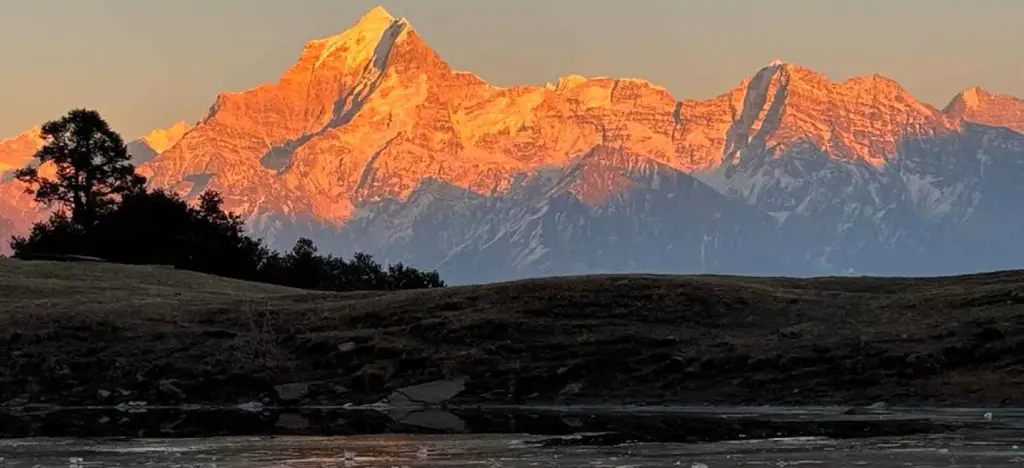
Weather Conditions
The Himalayas are notorious for their rapidly changing weather. Here’s what a typical visit will look like:
Summer: Average day temperature varies between 15°C to 25°C while night is around of 5°C to10° C.
Autumn: Days are warm, ranging from 10˚C to 20˚C while nights become cooler (0-5˚C).
Winter: Days are freezing with a range of between 0°C to 10°C; nights drop and are commonly around -10°C (or less). Expect significant snowfall.
Permits, Costs, and the Kuari Pass Trek Package
Forest permits are ncecessary for the Kuari Pass Trek. When you sign up for a package with The Mountain Trekker, we arrange all the paperwork and logistics – so that you can concentrate on the adventure.
TREK COMPLETE Our Kuari Pass Trek package is a complete trek, with no hidden charges whatsoever.
Transfers from Dehradun to Joshimath and Return.
Overnight in guesthouses and well-made tents.
All your trekking meals (very hygienic, nutritious and plentiful) 3 times food a day.
Skilled & certified trek leader and a local guide, who will lead the group.
All required permits and entry fees.
A fully equipped safety kit including first aid and emergency oxygen.
Hiking with a professional company like Hydro extreme adventures makes your trip safe, stress-free and informative.
Why to Trek with The Mountain Trekker?
“We here at The Mountain Trekker are motivated by the love of the mountains and determination to make every trekker’s trip an unforgettable experience.
Our team of Revenue Your company is headed by professional trekking guides and leaders who have over the years been involved in numerous treks in Nepalese Himalayas. They are not only guides, but your friends on the trail.
Safety First: Your safety is always our top priority. We follow strict safety procedures, use the best equipment, and have strong contingency plans.
Small Group Numbers: We prefer to operate small and intimate groups so that depending on size we can maintain a personal touch and respect high altitude responsibly with as little environmental impact as possible.
Stress-Free Packages: We take care of every things, from A to Z. All you have to do is turn up with your backpack and a sense of adventure.

Frequently Asked Questions (FAQs)
What is the level of difficulty on Kuari Pass Trek?
It is rated easy to moderate. It’s perfect for beginners in good condition. The walks also are not very long or over difficult terrain.
What are the shor Kuari Pass Trek Cost?
Packaged prices vary with the number of services and group size. Latest prices, please contact us FOB. We offer the most value with all of your essentials included!
When is the Best Time To Do Kuari Pass Trek?
Visibility is excellent in the autumn months (September-November). Spring (March-April) is great for the flowers; while winter (December-February) is perfect for a snow trek.
How do I get to the start of the trek?
The march begins at Dhak village near Joshimath. Closest major city to Auli is Dehradun and it has good connectivity via flight/train/road. Transport from Dehradun is part of our package.
Kuari Pass Trek for beginners – Is it a trek recommend?
Yes, absolutely. It is one of the best treks for beginners to experience a major Himalayan trail and see epic views without impossibly hard conditions.
Game for Lord Curzon’s Trail which takes you to an ancient trail used by the British?
What Kuari Pass Trek is all about ?
The Kuari Pass Trek is much more than a trek, infact it’s an expedition to the heart of the Himalayas as every step seems to come up with a new layer of nature and history! Let The Mountain Trekker guide you in this journey of adventure.
Get in touch today to reserve your place on the Kuari Pass Trek!, if you loved reading about this trek you might also like, Dayara bugyal trek


